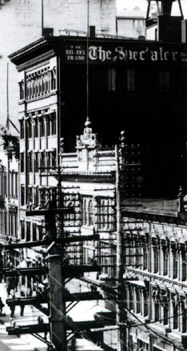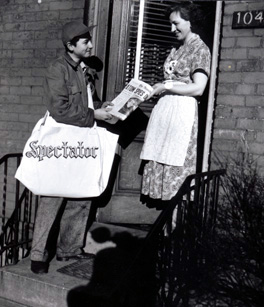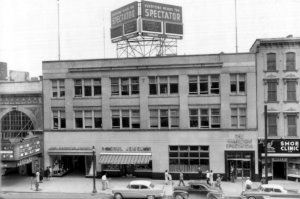THE HEART OF THE CITY
HAMILTON SPECTATOR

26-32 James Street South
 CURRENT STATUS (1999) Demolished
in mid-1970s
CURRENT STATUS (1999) Demolished
in mid-1970s
 BUILDING
INFORMATION
BUILDING
INFORMATION
Date Built: 1898
Original Owner: Hamilton Spectator
Original Use: Printing House
Subsequent Uses: N/A
Previous Building on Site: N/A
 ARCHITECTURE
ARCHITECTURE
Size: Six-storeys
Design and Style: N/A
Architect, Builder: W.P. Wilton, architect
Construction Materials: Rubbed Connecticut brown stone and manganese pressed brick
Architectural Features: N/A
In the early days of local journalism, there were many newspapers of varied types in
circulation. At that same time, a group of Hamilton men wanted a newspaper that was more
moderate in outlook than the very conservative Hamilton Gazette. A young master printer by
the name of Robert Reid Smiley was called to Hamilton and, above a drug store located on
James Street North, he published the first edition of the "Hamilton Spectator and
Journal of Commerce", using a second hand press capable of turning out 200 copies an
hour. The first edition was published on July 15, 1846, as a semi-weekly, having a modest
four pages. In the short span of a decade, the number of subscribers grew from a few
hundred to thousands. This increase changed the paper from a semi-weekly to a daily. By
1856, the publishers claimed to have one of the largest circulation of any Canadian
newspapers west of Toronto.
 After the death of Robert Smiley, the Spectator
passed into the management of his brother, John Smiley who unfortunately sold his interest
in the business and left for Chicago as there was not enough capital to back up the
business. Alexander Robertson then joined the company, under the firm name of Gillespy
& Robertson. For a few years they struggled, rather unsuccessfully, to keep the
company going. Some years later, the White Brothers, proprietors of the Spectator, gave
the business the financial strength it needed, returning the Spectator to a more solid
foundation. The White Brothers eventually sold the Spectator to Alexander Lawson, David
McCulloch, and Alexander Mars. It was under their editorial management that the Spectator
flourished. In 1873, the United States and Canada were hit with a financial panic whose
effects were felt immediately. Lawson, McCulloch & Company did not have enough money
saved to support the paper and were compelled to sell the business. The ailing Spectator
was put on the market, and was purchased by William Southam.
After the death of Robert Smiley, the Spectator
passed into the management of his brother, John Smiley who unfortunately sold his interest
in the business and left for Chicago as there was not enough capital to back up the
business. Alexander Robertson then joined the company, under the firm name of Gillespy
& Robertson. For a few years they struggled, rather unsuccessfully, to keep the
company going. Some years later, the White Brothers, proprietors of the Spectator, gave
the business the financial strength it needed, returning the Spectator to a more solid
foundation. The White Brothers eventually sold the Spectator to Alexander Lawson, David
McCulloch, and Alexander Mars. It was under their editorial management that the Spectator
flourished. In 1873, the United States and Canada were hit with a financial panic whose
effects were felt immediately. Lawson, McCulloch & Company did not have enough money
saved to support the paper and were compelled to sell the business. The ailing Spectator
was put on the market, and was purchased by William Southam.
Southam, superintendent of the Free Press, held a third of the shares of the company,
which he sold. Using this money and money he borrowed, he entered into a partnership with
William Carey. Together they, and a group of more than a dozen prominent Hamiltonians
raised enough funds to purchase the Hamilton Spectator. Both Southam and Carey invested
$4,000 with an additional $1,000 to be paid within a year. The balance of the required
funds was provided by the other members. In 1925, Southam fully owned the Spectator.
Over the years, the Spectator faced fierce and stiff competition from many other
notable papers, which included the Times and the Herald. It was under the management of
Southam that the Spectator, Hamilton’s twenty-third newspaper, flourished. Their
success resulted in the bowing out of their competitors, leaving the Spectator as the sole
survivor on the local journalism scene.
Over the course of the company’s career, the Spectator frequently changed
locations, each time securing both better equipment and better facilities for their
growing industry. The first printing office of 1846, was located the second floor over what was then Dalley’s Drug Store and which
would later become the Grafton Store, located on James Street North. From there, the
company moved to the building on James Street South, which it occupied from 1850 until it
moved to the site of the Wentworth Arms Hotel. It then relocated to the corner of James
and Main Streets. It then travelled to the Parke & Parke building, located on Market
Square.
what was then Dalley’s Drug Store and which
would later become the Grafton Store, located on James Street North. From there, the
company moved to the building on James Street South, which it occupied from 1850 until it
moved to the site of the Wentworth Arms Hotel. It then relocated to the corner of James
and Main Streets. It then travelled to the Parke & Parke building, located on Market
Square.
On January 23, 1884, papers reported that the Spectator had suffered extensive damage
from a fire that had broken out the previous night. An hour after the fire alarm sounded,
the floor of the job room was completely destroyed by flames which caused the two huge
printing presses to fall through the floor. An investigation into the fire concluded that
it began in the stockroom near the building’s elevator shaft. The flames shot up to
the roof via the shaft and spread across the length of the building. Sparks had also
fallen down the shaft a room where large quantities of newsprint were being stored. Within
minutes, the interior of the building was an inferno and beyond rescue. Despite the
tragedy, the morning paper made its appearance.
Within days, the management of the Spectator had purchased the building and equipment of
their former rival, The Tribune, located on James Street North, just north of Vine Street.
The paper was printed on this site for a short time.
In June of 1898, the Spectator moved into the six storey building on James Street North
where it remained until 1921. The building, designed by W. P. Wilton, and built in 1898,
was the first modern office building on the block. This six-storey building was said to
have been one of the finest office buildings in either Toronto or Hamilton at the time of
its erection. It was 75 square feet and the height of the front from the sidewalk to the
top of the cornices was 92 feet. The front of the building was constructed with rubbed
Connecticut brown stone and manganese pressed brick, and was topped with a copper cornice.
The  main entrances on James Street were ornamental,
while the halls were faced with enameled brick, and the floors were finished in a marble
mosaic construction. The staircase had carved mewels and turned balustrades, while the
offices were furnished in native woods. The then modern building was equipped with
electricity. The upper floors were rented out as office space, the second floor housed the
editorial staff, and the ground floor contained the Spectator’s main offices. A
three-storey building, located behind the main building, housed the type setting machines
and the printing presses. An editorial appearing in the paper of April 9, 1898, referred
to the Spectator office as "the newspaper palace."
main entrances on James Street were ornamental,
while the halls were faced with enameled brick, and the floors were finished in a marble
mosaic construction. The staircase had carved mewels and turned balustrades, while the
offices were furnished in native woods. The then modern building was equipped with
electricity. The upper floors were rented out as office space, the second floor housed the
editorial staff, and the ground floor contained the Spectator’s main offices. A
three-storey building, located behind the main building, housed the type setting machines
and the printing presses. An editorial appearing in the paper of April 9, 1898, referred
to the Spectator office as "the newspaper palace."
In 1921, the company relocated to a building on King Street East, across from the Royal Connaught Hotel, where it remained until their final move. This
location provided for plenty of highly visible downtown frontage on the north side of King
Street. The majority of the building occupied the entire block between King Street East
and King William, from the Loew’s Theatre to Catharine
Street. On April 1, 1953, the paper announced that the building formerly occupied by the
Spectator, located at 24 James Street South had been had been purchased by the Royal Bank and was slated for demolition to make way for a modern
office building, which was to be ready for occupation on January 1, 1955. On October 14,
1976, the Spectator held its official grand opening of their new location, and present
home, located at 44 Frid Street, in West Hamilton. The value of the plant was estimated to
be worth $23,000,000.
The Spectator has always sought to "provide readers with a daily package of
information, background, analysis and  interpretation" (Spectator, April 24, 1995).
As a paper, they desire to inform, educate, and entertain their subscribers. The
Spectator’s policy has always sought "to present world-wide news carefully
edited and from the most authoritative sources." Today, their goal is no different.
interpretation" (Spectator, April 24, 1995).
As a paper, they desire to inform, educate, and entertain their subscribers. The
Spectator’s policy has always sought "to present world-wide news carefully
edited and from the most authoritative sources." Today, their goal is no different.
From the early days to the present, the Spectator has seen a continual increase in
subscription. Today, the Spectator is delivered to an extensive area encompassing
Hamilton, Burlington, Ancaster, Dundas, Stoney Creek, Waterdown, Winona, Grimsby, and
regions South of Highway 53.
In 1995, The Spectator, again in keeping with modern demands, changed the delivery
times. After having polled readers for two years, the Spectator implemented an early
morning delivery time, which changed from the previous afternoon delivery. Papers were to
be delivered by 6 a.m. in order to beat out the competition, which research had shown to
have ensured delivery by 7 a.m..
The Spectator is presently equipped with some of the most efficient technology for
their industry. According to information printed in 1995, the Spectator’s presses
were then capable of printing 50,000 newspapers per hour or 1,700,000 pages per hour. An
article in the April 24, 1995 paper highlighted the fact that the presses were capable of
covering as much as 160 miles of newsprint every hour.
The Spectator was and is a key element of the City of Hamilton, tirelessly reporting
the news that affects the citizens of the region. The great number of subscribers attest
to its informative importance and to its journalistic success.
See also: www.hamiltonspectator.com
REFERENCES:
Bailey, T. Melville. Hamilton, Chronicle of a City.
Canada: Windsor Publications, 1983.
Bruce, Charles. News and the Southams. Toronto: MacMillan of Canada, 1968.
Clipping File – Hamilton – Newspapers – General. Special Collections, HPL.
Clipping File – Hamilton – Newspapers – The Spectator. Special Collections,
HPL.
Clipping File – Hamilton – Strikes – 1946. Special Collections, HPL.
Clipping File – Office Buildings – Spectator Office Building. Special
Collections, HPL.
Clipping File – Office Buildings – Spectator Office Building. Special
Collections, HPL.
Hamilton, The Storey of a City. Special Collections, HPL.
Katz, Michael. The People of Hamilton, Canada West. United States: Harvard
University Press, 1975.
Our Heritage Scrapbook, Vol. 1. Special Collections, HPL.
Our Heritage Scrapbook, Vol. 2. Special Collections, HPL.
Spectator Scrapbook, Vol. 3. Special Collections, HPL.
Spectator Scrapbook, Vol. 4. Special Collections, HPL.
The Spectator, Dawn of A New Era, April 24, 1995. Special Collections, HPL.
Victorian Hamilton Scrapbook, Vol. 3. Special Collections, HPL.
Victorian Hamilton Scrapbook, Vol. 21. Special Collection, HPL.
Woodhouse, T. Roy. History of the Town of Dundas Pt 3 of a Series. Dundas: Dundas
Historical Society, 1969.


![]() CURRENT STATUS (1999) Demolished
in mid-1970s
CURRENT STATUS (1999) Demolished
in mid-1970s After the death of Robert Smiley, the Spectator
passed into the management of his brother, John Smiley who unfortunately sold his interest
in the business and left for Chicago as there was not enough capital to back up the
business. Alexander Robertson then joined the company, under the firm name of Gillespy
& Robertson. For a few years they struggled, rather unsuccessfully, to keep the
company going. Some years later, the White Brothers, proprietors of the Spectator, gave
the business the financial strength it needed, returning the Spectator to a more solid
foundation. The White Brothers eventually sold the Spectator to Alexander Lawson, David
McCulloch, and Alexander Mars. It was under their editorial management that the Spectator
flourished. In 1873, the United States and Canada were hit with a financial panic whose
effects were felt immediately. Lawson, McCulloch & Company did not have enough money
saved to support the paper and were compelled to sell the business. The ailing Spectator
was put on the market, and was purchased by William Southam.
After the death of Robert Smiley, the Spectator
passed into the management of his brother, John Smiley who unfortunately sold his interest
in the business and left for Chicago as there was not enough capital to back up the
business. Alexander Robertson then joined the company, under the firm name of Gillespy
& Robertson. For a few years they struggled, rather unsuccessfully, to keep the
company going. Some years later, the White Brothers, proprietors of the Spectator, gave
the business the financial strength it needed, returning the Spectator to a more solid
foundation. The White Brothers eventually sold the Spectator to Alexander Lawson, David
McCulloch, and Alexander Mars. It was under their editorial management that the Spectator
flourished. In 1873, the United States and Canada were hit with a financial panic whose
effects were felt immediately. Lawson, McCulloch & Company did not have enough money
saved to support the paper and were compelled to sell the business. The ailing Spectator
was put on the market, and was purchased by William Southam. what was then Dalley’s Drug Store and which
would later become the Grafton Store, located on James Street North. From there, the
company moved to the building on James Street South, which it occupied from 1850 until it
moved to the site of the Wentworth Arms Hotel. It then relocated to the corner of James
and Main Streets. It then travelled to the Parke & Parke building, located on Market
Square.
what was then Dalley’s Drug Store and which
would later become the Grafton Store, located on James Street North. From there, the
company moved to the building on James Street South, which it occupied from 1850 until it
moved to the site of the Wentworth Arms Hotel. It then relocated to the corner of James
and Main Streets. It then travelled to the Parke & Parke building, located on Market
Square.  main entrances on James Street were ornamental,
while the halls were faced with enameled brick, and the floors were finished in a marble
mosaic construction. The staircase had carved mewels and turned balustrades, while the
offices were furnished in native woods. The then modern building was equipped with
electricity. The upper floors were rented out as office space, the second floor housed the
editorial staff, and the ground floor contained the Spectator’s main offices. A
three-storey building, located behind the main building, housed the type setting machines
and the printing presses. An editorial appearing in the paper of April 9, 1898, referred
to the Spectator office as "the newspaper palace."
main entrances on James Street were ornamental,
while the halls were faced with enameled brick, and the floors were finished in a marble
mosaic construction. The staircase had carved mewels and turned balustrades, while the
offices were furnished in native woods. The then modern building was equipped with
electricity. The upper floors were rented out as office space, the second floor housed the
editorial staff, and the ground floor contained the Spectator’s main offices. A
three-storey building, located behind the main building, housed the type setting machines
and the printing presses. An editorial appearing in the paper of April 9, 1898, referred
to the Spectator office as "the newspaper palace." interpretation" (Spectator, April 24, 1995).
As a paper, they desire to inform, educate, and entertain their subscribers. The
Spectator’s policy has always sought "to present world-wide news carefully
edited and from the most authoritative sources." Today, their goal is no different.
interpretation" (Spectator, April 24, 1995).
As a paper, they desire to inform, educate, and entertain their subscribers. The
Spectator’s policy has always sought "to present world-wide news carefully
edited and from the most authoritative sources." Today, their goal is no different.